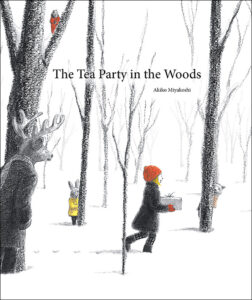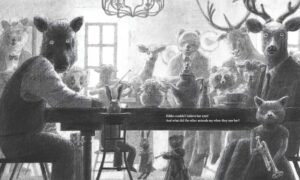 The Tea Party in the Woods
The Tea Party in the Woods
By Akiko Miyakoshi
Kids Can Press
$16.95
ISBN: 978-1771381079
Ages 3-6
There are picture books out there that feel like short films. Some of the time they’re adapted into them (as with The Snowman or The Lost Thing or Lost and Found) and sometimes they’re made in tandem (The Fantastic Flying Books of Morris Lessmore). And some of the time you know, deep in your heart of hearts, that they will never see the silver screen. That they will remain perfect little evocative pieces that seep deep into the softer linings of a child’s brain, changing them, affecting them, and remaining there for decades in some form. The Tea Party in the Woods is like that. It looks on first glance like what one might characterize to be a “quiet” book. Upon further consideration, however, it is walking the tightrope between fear and comfort. We are in safe hands from the start to the finish but there’s no moment when you relax entirely. In this strangeness we find a magnificent book.
Having snowed all night, Kikko’s father takes off through the woods to shovel out the walk of her grandmother. When he forgets to bring along the pie Kikko’s mother baked for the occasion, Kikko takes off after him. She knows the way but when she spots him in the distance she smashes the pie in her excitement. Catching up, there’s something strange about her father. He enters a house she’s never seen before. Upon closer inspection, the man inside isn’t a man at all but a bear. A sweet lamb soon invites Kikko in, and there she meets a pack of wild animals, all polite as can be and interested in her. When she confesses to having destroyed her grandmother’s cake, they lend her slices of their own, and then march her on her way with full musical accompaniment.
 Part of what I like so much about this book is that when a kid reads it they’re probably just taking it at face value. Girl goes into woods, hangs out with clothed furry denizens, and so on, and such. Adults, by contrast, are bringing to the book all sorts of literary, cinematic, and theatrical references of their own. A girl entering the woods with red on her head so as to reach her grandmother’s reeks of Little Red Riding Hood (and I can neither confirm nor deny the presence of a wolf at the tea party). The story of a girl wandering into the woods on her own and meeting the wild denizens who live there for a feast makes the book feel like a best case fairy encounter scenario. In this light the line, “You’re never alone in the woods”, so comforting here, takes on an entirely different feel. Some have mentioned comparisons to Alice in Wonderland as well, but the tone is entirely different. This is more akin to the meal with the badgers in The Lion, the Witch, and the Wardrobe than anything Lewis Carroll happened to cook up.
Part of what I like so much about this book is that when a kid reads it they’re probably just taking it at face value. Girl goes into woods, hangs out with clothed furry denizens, and so on, and such. Adults, by contrast, are bringing to the book all sorts of literary, cinematic, and theatrical references of their own. A girl entering the woods with red on her head so as to reach her grandmother’s reeks of Little Red Riding Hood (and I can neither confirm nor deny the presence of a wolf at the tea party). The story of a girl wandering into the woods on her own and meeting the wild denizens who live there for a feast makes the book feel like a best case fairy encounter scenario. In this light the line, “You’re never alone in the woods”, so comforting here, takes on an entirely different feel. Some have mentioned comparisons to Alice in Wonderland as well, but the tone is entirely different. This is more akin to the meal with the badgers in The Lion, the Witch, and the Wardrobe than anything Lewis Carroll happened to cook up.
Yet it is the art that is, in many ways, the true allure. Kirkus compared the art to both minimalist Japanese prints as well as Dutch still life’s. Miyakoshi does indeed do marvelous things with light, but to my mind it’s the use of color that’s the most impressive. Red and yellow and the occasional hint of orange/peach appear at choice moments. Against a sea of black and white they draw your eye precisely to where it needs to go. That said, I felt it was Miyakoshi’s artistic choices that impressed me most. Nowhere is this more evident than when Kikko  enters the party for the first time, every animal in the place staring at her. It’s a magnificent image. The best in the book by far. Somehow, Miyakoshi was able to draw this scene in such a way where the expressions on the animals’ faces are ambiguous. It isn’t just that they are animals. First and foremost, it seems clear that they are caught entirely unguarded in Kikko’s presence. The animals that had been playing music have stopped mid-note. And I, an adult, looked at this scene and (as I mentioned before) applied my own interpretation on how things could go. While it would be conceivable for Kikko to walk away from the party unscathed, in the hands of another writer she could easily have ended up the main course. That is probably why Miyakoshi follows up that two-page spread (which should have been wordless, but that’s neither here nor there) with an immediate scene of friendly, comforting words and images. The animals not only accept Kikko’s presence, they welcome her, are interested in her, and even help her when they discover her plight (smashing her grandmother’s pie). Adults everywhere who have found themselves unaccompanied (and even uninvited) at parties where they knew no one, and will recognize in this a clearly idyllic, unapologetically optimistic situation. In other words, perfect picture book fodder.
enters the party for the first time, every animal in the place staring at her. It’s a magnificent image. The best in the book by far. Somehow, Miyakoshi was able to draw this scene in such a way where the expressions on the animals’ faces are ambiguous. It isn’t just that they are animals. First and foremost, it seems clear that they are caught entirely unguarded in Kikko’s presence. The animals that had been playing music have stopped mid-note. And I, an adult, looked at this scene and (as I mentioned before) applied my own interpretation on how things could go. While it would be conceivable for Kikko to walk away from the party unscathed, in the hands of another writer she could easily have ended up the main course. That is probably why Miyakoshi follows up that two-page spread (which should have been wordless, but that’s neither here nor there) with an immediate scene of friendly, comforting words and images. The animals not only accept Kikko’s presence, they welcome her, are interested in her, and even help her when they discover her plight (smashing her grandmother’s pie). Adults everywhere who have found themselves unaccompanied (and even uninvited) at parties where they knew no one, and will recognize in this a clearly idyllic, unapologetically optimistic situation. In other words, perfect picture book fodder.
Translation is a delicate art. Done well, it creates some of our greatest children’s literature masterpieces. Done poorly and the book just melts away from the publishing world like mist, as if it was never there. Because I do not have a final copy of this book in hand, I don’t know if the translator for this book is ever named. Whoever they are, I think they knew precisely how to tackle it. Originally published in what I believe to be Japan, I marvel even now at how the story opens. The first line reads, “That morning, Kikko had awoken to a winter wonderland.” We are plunged into the story in such as way as to believe that we’ve been reading about Kikko for quite some time. It doesn’t say “One morning”, which is a distinction of vast importance. It says “That morning” and we are left to consider why that choice was made. What happened before “That morning” that led up to the events of this particular day? Whole short stories have been conjured from less. I love it.
If none of the reasons I’ve mentioned do it for you, consider this: On the front inside book flap of this book perches a squirrel in a bright red party dress in the crook of a tree. Tiny squirrel. Tiny red flowing gown. A detail you might easily miss the first ten times you read this book but it is there and just makes the book for me. Add in the tone, the light, the mood, and the writing itself and you have a book that will be remembered long after the name has faded from its readers’ minds. Something about this book will stick with your kids for all time. If you want something that feels classic and safely dangerous, Miyakoshi’s book is a rare piece of comfortable animal noir. No one is alone in the woods and after this book no one would want to be.
On shelves now.
Source: Galley sent from publisher for review.
Like This? Then Try:
- The Moon Jumpers by Janice Udry, ill. Maurice Sendak
- Lenny & Lucy by Philip C. Stead, ill. Erin E. Stead
- Into the Forest by Anthony Browne



Boy, Betsy. When you love a book it brings out the best in you. What a beautiful review of what is clearly a wonderful book.
A wonderful review Betsy. I must get my hands on a copy. Thank you !